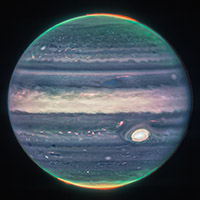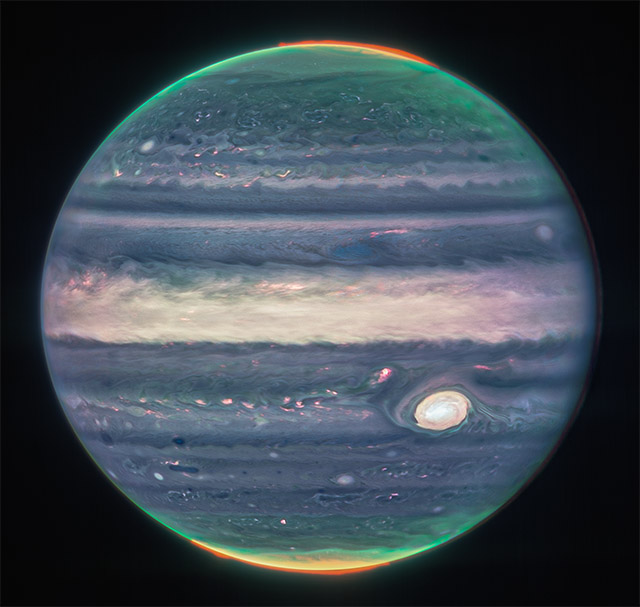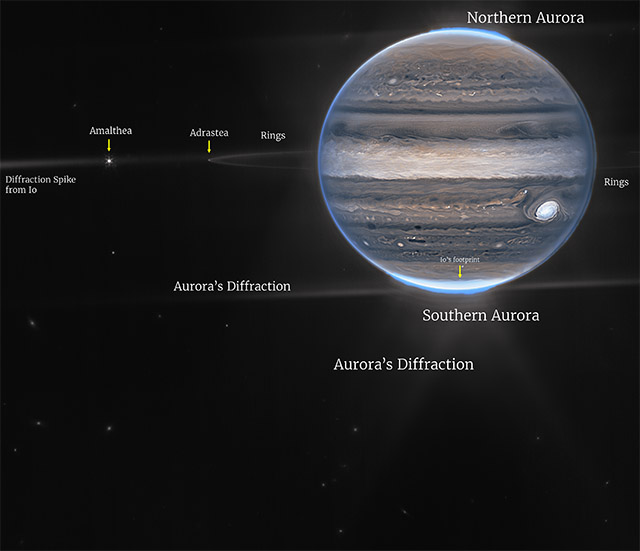Webb captures beautiful images of Jupiter, showing aurorae and fascinating atmospheric haze
posted Tuesday, August 23, 2022 at 2:30 PM EDT

While the James Webb Space Telescope is designed to investigate distant celestial objects, it's well-suited to looking closely at objects much closer to home, too. NASA has shared new images that Webb captured of Jupiter. The observations showcase aurorae, haze and will give scientists more information about Jupiter's "inner life."
"We hadn't really expected it to be this good, to be honest," said planetary astronomer Imke de Pater, professor emerita of the University of California, Berkeley. "It's really remarkable that we can see details on Jupiter together with its rings, tiny satellites, and even galaxies in one image," she said. De Pater led the Jupiter observations with Thierry Fouchet, a professor at the Paris Observatory.
Webb captured two images using its Near-Infrared Camera (NIRCam). The camera includes three specialized infrared filters that help bring out incredible detail in Jupiter. The infrared light, which we can't see with the naked eye, has been mapped onto the visible spectrum. The longest wavelengths appear redder, while the shortest wavelengths are shown in blue.

Credit: NASA, ESA, CSA, Jupiter ERS Team; image processing by Judy Schmidt.
Click here to see the full-size image.
The composite image shows aurorae extending to the high altitudes above the gas giant's northern and southern poles. The auroras show in a filter mapped to redder colors. A different filter, mapped to yellows and greens, shows haze around the poles. A third filter, mapped to blues, shows light reflected from a "deeper main cloud." The Great Red Spot, Jupiter's famous storm, appears white. Other clouds appear white, too. The Great Spot is so big that it "could swallow Earth."
"The brightness here indicates high altitude – so the Great Red Spot has high-altitude hazes, as does the equatorial region," said Heidi Hammel, Webb interdisciplinary scientist for solar system observations and vice president for science at AURA. "The numerous bright white 'spots' and 'streaks' are likely very high-altitude cloud tops of condensed convective storms."
The wider field below shows Jupiter's faint rings. These rings are about a million times fainter than the planet itself. You can also see a pair of moons, Amalthea and Adrastea. The fuzzy spots in the background are likely galaxies.

Credit: NASA, ESA, CSA, Jupiter ERS Team; image processing by Ricardo Hueso (UPV/EHU) and Judy Schmidt.
Click here to see the full-size image. The non-annotated version is available here.
NASA's Jupiter system program studies the dynamic and chemistry of Jupiter, its rings, and its corresponding satellite system. The team is poring over data from Webb to learn more about our solar system's largest planet.
The data arrives in a complex array of information. Webb sends information about the brightness of the light its detectors receive, and scientists must then process the data into calibrated files for analysis. Scientists then package the results into information and visuals easily digestible to the public. Information is also shared with citizen scientists, who then provide further processing and analysis.
One such citizen scientist is Judy Schmidt of Modesto, CA, who helped with the image processing seen in this article. Schmidt is a longtime member of the citizen scientist community. She collaborated with Ricardo Hueso, a co-investigator on Webb's Jovian investigations. Hueso studies planetary atmospheres at the University of the Basque Country in Spain. Schmidt has no formal educational background in astronomy but has been an important member of the citizen scientist community for the last decade. She took third place in the "Hubble's Hidden Treasures" contest. Since then, processing telescope data has become a hobby for Schmidt.
Schmidt remarked that processing data from Jupiter is especially challenging because of how fast the planet rotates. She must make precise digital adjustments when stacking images to ensure that everything lines up. Webb will produce a lot of data over the next 10 years and beyond. Schmidt is especially excited to work with Webb's views of star-forming regions.
(Via NASA)